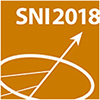Speaker
Description
Research at extreme P-T conditions forces the available technologies and material properties to their limits. The Paris-Edinburgh press (PE press) yields a suitable technology for generating stable static pressures (10´s of GPa) on large sample volume (< 3mm3). In the past, two PE presses have been modified to such a degree that accelerated heavy ions can reach condensed matter hold at high pressure. The specially developed anvils manufactured of tungsten carbide enclose new one-side spherical diamonds (diamond diameter = 2.7 mm). These diamond windows open the pathway for optical and spectroscopic measurements during ion irradiation. With this novel originated press setup, it is possible to retrieve pressure and temperature data by measuring the shift of Raman bands or fluorescence lines of standard material. The poster will provide insight into the latest technological developments. One of the PE presses has been modified to perform swift heavy ion irradiation of condensed matter at high pressure and medium high temperatures (<900 K). The second PE press will been customized to operate at medium low temperatures (200 - 300 K). Currently, the PE cell with a heating set up is undergoing feasibility tests. In October, also investigations with simultaneously ion irradiation are planned at the Cave A at GSI, Darmstadt. The aim of the research is to conduct experimental studies in such a way that radioactive decay and its effect to Earth mantle rocks at HT/HP-conditions can be simulated. In addition, the low temperature research aims to simulate the interaction of cosmic radiation on ice on planetary surfaces in space.

